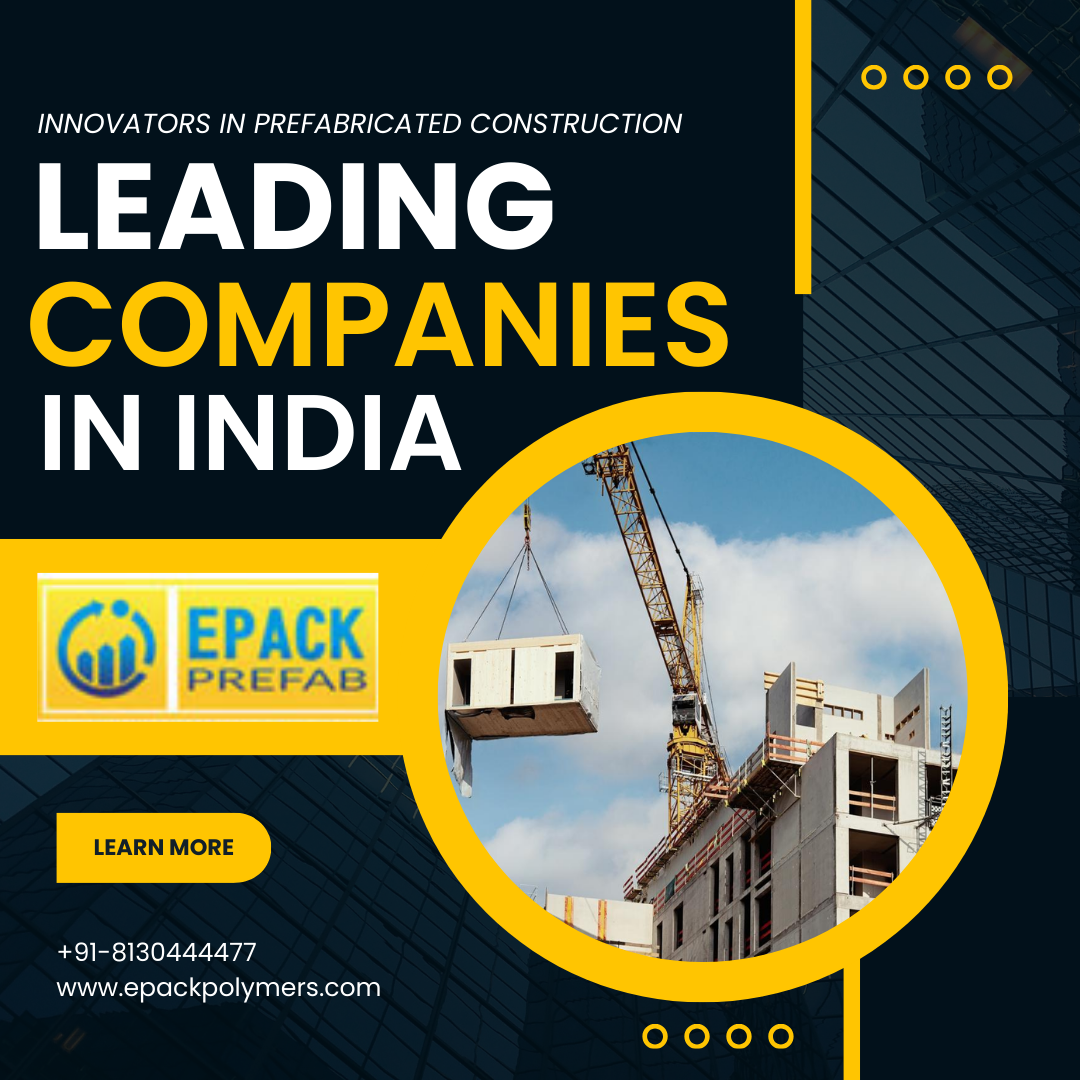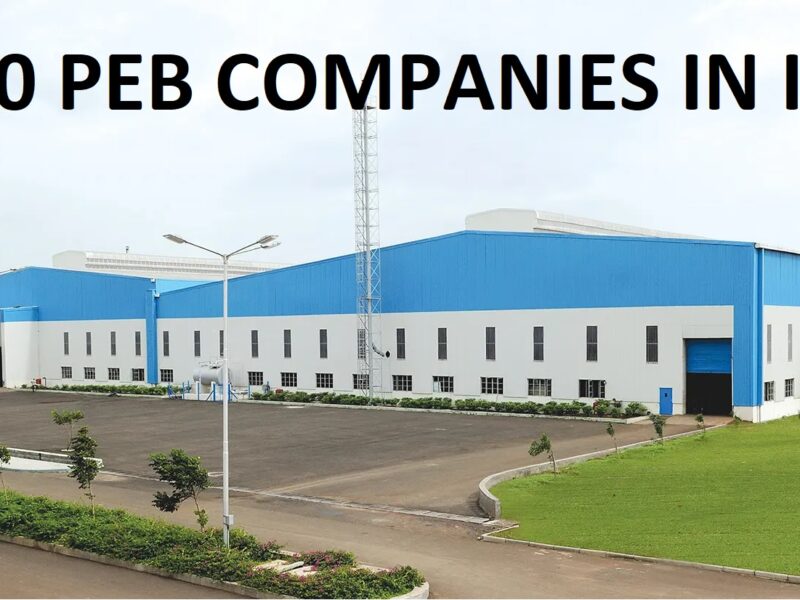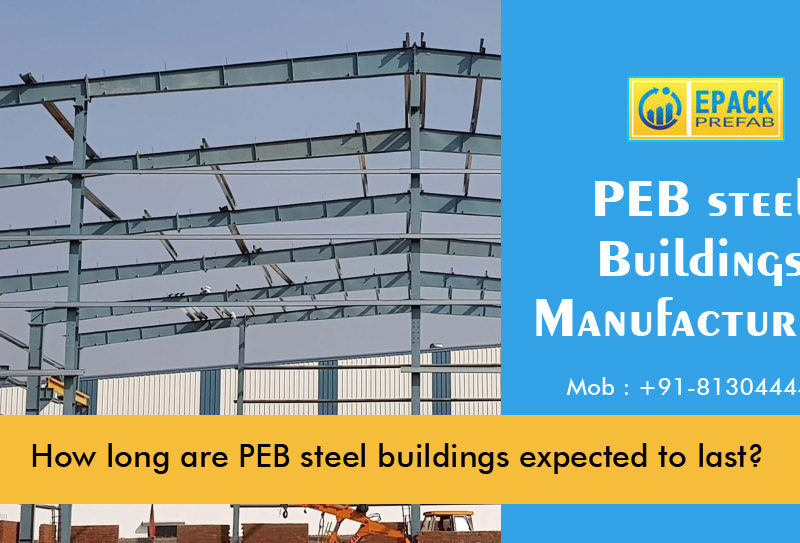Leading the Charge: Prefabricated Construction Innovators in India
In the dynamic realm of prefabricated construction, EPACK Prefab stands out as a trailblazer, embodying innovation and excellence. As one of the top companies in India, EPACK Prefab has redefined the landscape of construction with its cutting-edge solutions and commitment to quality.
EPACK Prefab is recognized among the Best companies in India for its unwavering dedication to delivering top-notch prefabricated structures. With a focus on efficiency and sustainability, EPACK Prefab has become a synonym for excellence in the construction industry.
As a frontrunner among the top companies in India, EPACK Prefab sets the benchmark for quality and innovation. Leveraging advanced technologies and a skilled workforce, the company consistently delivers projects that meet and exceed the expectations of clients.
EPACK Prefab’s position as the best company in India for prefabricated construction is fortified by its diverse portfolio of successful projects. From commercial spaces to residential complexes, EPACK Prefab has left an indelible mark, showcasing its prowess in the industry.
What distinguishes EPACK Prefab from other top companies in India is its relentless pursuit of perfection. The company’s commitment to excellence, coupled with a customer-centric approach, has earned it a stellar reputation as a leader in the field of prefabricated construction.
In conclusion, EPACK Prefab emerges as a standout among the top companies in India, shaping the future of construction through innovation and a dedication to unparalleled quality. As the best company in India for prefabricated construction, EPACK Prefab continues to redefine industry standards, leaving an enduring legacy of excellence.
The Rise of Prefabricated Construction in India
In recent years, the construction landscape in India has witnessed a transformative shift with the rising prominence of prefabricated construction methods. This innovative approach to building has gained significant traction, redefining the way structures are designed and erected across the country.
Prefabricated construction is on the ascent in India, and the trend shows no signs of slowing down. A key factor contributing to this rise is the efficiency and speed offered by prefabricated techniques. Construction projects that once took months to complete can now be accomplished in a fraction of the time, thanks to the streamlined processes inherent in prefabrication.
Moreover, the environmental benefits of prefabricated construction have propelled its popularity. As sustainability takes center stage in the construction industry, prefabrication emerges as a eco-friendly solution, minimizing waste and reducing the overall environmental impact of building projects.
The cost-effectiveness of prefabricated construction further fuels its ascent. With reduced labor requirements and optimized material usage, this method proves to be not only efficient but also economical. This has led to an increased adoption by both residential and commercial sectors, further solidifying the rise of prefabricated construction in India.
Leading the charge in this construction revolution are companies like EPACK Prefab, standing out among the top players in the industry. Their commitment to innovation and quality aligns seamlessly with the evolving preferences in the construction sector, contributing significantly to the upward trajectory of prefabricated construction in India.
Key Advantages of Prefabricated Construction
Prefabricated construction has witnessed a surge in popularity, thanks to its numerous advantages that revolutionize traditional building methods. Embracing this innovative approach offers a range of benefits, making it a preferred choice for forward-thinking builders and developers.
1. Speed and Efficiency: One of the foremost advantages of prefabricated construction is its remarkable speed. Unlike traditional methods, where on-site construction can be time-consuming, prefabrication allows for simultaneous manufacturing and site preparation, significantly reducing overall project timelines. This efficiency translates into cost savings and quicker occupancy.
2. Cost-Effective Solutions: Prefabricated construction often proves to be more cost-effective than traditional building methods. The streamlined manufacturing process, reduced labor costs, and minimized material wastage contribute to a more budget-friendly option for builders. This financial advantage makes prefabrication an attractive choice for projects with tight budgets.
3. Quality Control: Prefabricated construction enables meticulous quality control in a controlled factory environment. The use of advanced technology and standardized processes ensures that each component meets stringent quality standards. This results in consistently high-quality structures, minimizing the risk of defects and errors commonly associated with on-site construction.
4. Sustainability and Reduced Waste: Emphasizing sustainability, prefabricated construction minimizes material wastage. Precise measurements and optimized material usage in the manufacturing process contribute to reduced environmental impact. Additionally, the controlled factory setting allows for the efficient recycling of waste materials, aligning with green building practices.
5. Flexibility in Design: Contrary to the misconception that prefabricated construction limits design options, it offers remarkable flexibility. Modern prefabrication techniques cater to a wide range of architectural styles and design preferences. Builders can customize modular components to meet specific project requirements, ensuring a unique and aesthetically pleasing outcome.
6. Weather-Independent Construction: Prefabricated construction minimizes the impact of weather conditions on the building process. Since a significant portion of construction occurs within a climate-controlled factory, adverse weather on-site becomes less of a hindrance. This ensures consistent progress and reduces the risk of delays due to weather-related issues.
7. Enhanced Safety Measures: The factory-controlled environment of prefabricated construction contributes to improved safety standards. With reduced on-site activities and potential hazards, the risk of accidents and injuries is significantly lowered. This prioritization of safety aligns with contemporary construction practices that prioritize the well-being of workers and project stakeholders.
Innovations in Prefabricated Construction
The realm of prefabricated construction is undergoing a transformative phase, driven by groundbreaking innovations that redefine traditional building methods. From cutting-edge materials to advanced construction techniques, the industry is witnessing a paradigm shift led by companies like EPACK Prefab.
EPACK Prefab, at the forefront of innovations in prefabricated construction, introduces modular solutions that not only expedite the building process but also enhance structural integrity. The company’s commitment to sustainable practices is evident in the incorporation of eco-friendly materials, showcasing a forward-thinking approach to construction.
Innovations in design play a pivotal role, and EPACK Prefab is spearheading this aspect with customizable and aesthetically pleasing prefabricated structures. The integration of smart technologies further enhances functionality, offering clients a modern and efficient living or working space.
One notable innovation by EPACK Prefab is the utilization of advanced insulation materials, ensuring energy efficiency and reduced environmental impact. This commitment to eco-friendly practices aligns with the global push towards sustainable construction solutions.
The adoption of Building Information Modeling (BIM) is another groundbreaking innovation by EPACK Prefab, revolutionizing the planning and execution phases of construction. This technology-driven approach enhances precision, minimizes errors, and optimizes resource utilization.
Innovations in Prefabricated Construction
Embracing the future of construction, innovations in prefabricated construction have become a catalyst for transformative change in the industry. This paradigm shift is evident in the seamless integration of advanced technologies and sustainable practices, reshaping the way buildings are designed and erected.
- Revolutionizing Design Processes
In the realm of prefabricated construction, innovation begins with reimagining design processes. Modern technologies like Building Information Modeling (BIM) enable precise planning and visualization, ensuring that every component fits seamlessly into the final structure. This innovation minimizes errors, reduces waste, and accelerates project timelines.
- Smart Modular Systems
The advent of smart modular systems marks a significant leap forward in prefabricated construction. These systems incorporate intelligent technologies that enhance efficiency, safety, and functionality. From automated assembly lines to IoT-enabled components, these innovations streamline the construction process, offering a glimpse into the future of intelligent building solutions.
- Sustainable Material Integration
Innovations in prefabricated construction extend beyond efficiency to sustainability. Leading companies are integrating eco-friendly materials and practices into their prefabrication processes. From recycled steel structures to energy-efficient insulation, these innovations prioritize environmental responsibility without compromising structural integrity.
- Off-Site Construction Techniques
Off-site construction techniques represent a groundbreaking innovation in prefabricated construction. The ability to fabricate building components in a controlled factory environment not only ensures precision but also reduces the environmental impact of on-site construction. This innovation minimizes disruption to local communities, making prefabricated construction a more sustainable and community-friendly option.
- Integration of 3D Printing
The integration of 3D printing technology is revolutionizing how prefabricated construction components are manufactured. This innovative approach allows for the creation of intricate and customized building elements with unprecedented speed and accuracy. As 3D printing continues to advance, its application in prefabricated construction holds the potential to redefine the possibilities of architectural design.
- Energy-Efficient Prefabricated Modules
In response to the growing emphasis on sustainable practices, innovations in prefabricated construction now include energy-efficient modules. These modules incorporate state-of-the-art insulation, solar panels, and smart energy management systems, contributing to a greener and more cost-effective approach to construction.
- Prefabrication Robotics
The incorporation of robotics in prefabricated construction represents a futuristic innovation that enhances precision and speed. Automated robots can perform tasks such as welding, cutting, and assembling components with unmatched accuracy, reducing labor costs and project timelines.
Challenges and Solutions in Prefabricated Construction
In the realm of prefabricated construction, where innovation is at the forefront, challenges often arise hand in hand with advancements. One of the primary hurdles faced by companies in this sector is the perception challenge. Prefabricated construction, although gaining popularity, still encounters skepticism. Educating stakeholders about the benefits and debunking myths is an ongoing challenge that the industry grapples with.
Logistical challenges pose another obstacle. Coordinating the transportation and assembly of prefabricated components demands meticulous planning. Ensuring that modules arrive on-site in the right sequence and are seamlessly integrated requires strategic logistics management—a challenge that requires constant refinement in execution.
Moreover, customization demands add a layer of complexity. Balancing the efficiency of mass production with the need for tailored solutions challenges companies in the prefabricated construction sector. Striking the right balance between standardization and customization is an ongoing dilemma for industry players.
On the flip side, solutions are continually being devised to overcome these challenges. Industry leaders are actively engaging in awareness campaigns, emphasizing the durability, sustainability, and cost-effectiveness of prefabricated construction. Moreover, advancements in technology facilitate improved logistics planning and execution, addressing the transportation challenges faced by the sector.
In terms of customization, innovative design technologies and modular systems are being developed to provide flexibility without compromising efficiency. Companies are investing in research and development to offer prefabricated solutions that can be seamlessly adapted to diverse project requirements.
Future Trends in the Industry
As the construction landscape evolves, future trends in the industry point towards transformative changes that promise to redefine the way we build. Sustainable construction practices are set to take center stage, with a growing emphasis on eco-friendly materials and energy-efficient designs. Prefabricated construction, exemplified by leaders like EPACK Prefab, is poised to become even more prevalent, offering quicker project timelines and reduced environmental impact.
Innovations in technology, such as advanced robotics and artificial intelligence, are expected to revolutionize construction processes. Automation not only streamlines tasks but also enhances precision, ensuring higher quality in every project. Augmented reality (AR) and virtual reality (VR) are likely to play a significant role in the planning and visualization stages, providing stakeholders with immersive experiences that facilitate better decision-making.
Customization is emerging as a key trend, with a shift towards personalized and modular designs. Companies like EPACK Prefab are anticipated to lead in offering tailor-made solutions, catering to diverse client needs. This trend aligns with the growing demand for unique and aesthetically pleasing structures in both residential and commercial spaces.
The adoption of smart technology within buildings is another trend gaining momentum. From energy-efficient systems to integrated smart home features, the future of construction leans towards creating structures that are not only visually appealing but also technologically advanced for enhanced comfort and efficiency.
Sustainable Practices in Prefabricated Construction
In the realm of prefabricated construction, the spotlight is increasingly turning towards sustainable practices that not only revolutionize the industry but also contribute positively to the environment. Prefabrication, by its nature, offers inherent advantages in terms of efficiency, and when coupled with sustainable practices, it becomes a powerful force for positive change.
1. Material Selection for Eco-Friendly Footprint
Leading the charge in sustainable prefabricated construction is the careful selection of materials. Companies are now opting for eco-friendly, recycled, and responsibly sourced materials, ensuring a reduced environmental impact while maintaining structural integrity.
2. Energy-Efficient Design and Construction Processes
Innovative designs and construction processes prioritize energy efficiency, aiming to minimize the carbon footprint of prefabricated structures. From modular components designed for optimal insulation to energy-efficient HVAC systems, sustainability is integrated into every phase of construction.
3. Waste Reduction and Recycling Initiatives
Sustainable prefabricated construction involves meticulous waste management and recycling initiatives. Companies are adopting practices to minimize construction waste, repurpose materials, and recycle components, thereby contributing to a circular economy and reducing overall environmental impact.
4. Green Certifications and Compliance
To establish themselves as leaders in sustainable practices, companies in prefabricated construction are actively seeking and adhering to green certifications. These certifications validate adherence to strict environmental standards, assuring clients of a commitment to sustainability.
5. Integration of Renewable Energy Sources
Embracing renewable energy sources is a key aspect of sustainable prefabricated construction. Companies are incorporating solar panels, energy-efficient lighting, and other green technologies into their designs, aiming to create structures that generate and utilize clean energy.
6. Longevity and Durability for Reduced Lifecycle Environmental Impact
Sustainable practices extend beyond the construction phase to the longevity and durability of prefabricated structures. Designing and constructing buildings with a focus on longevity reduces the need for frequent replacements, minimizing the overall environmental impact over the structure’s lifecycle.
7. Community and Environmental Awareness Programs
Leading companies in prefabricated construction are actively engaging in community and environmental awareness programs. By educating stakeholders on the benefits of sustainable practices, these companies contribute to a broader understanding and adoption of eco-friendly construction methods.
FAQs
- Is prefabricated construction only suitable for specific types of buildings?
No, prefabricated construction is versatile and can be applied to various types of structures, including residential, commercial, and industrial buildings. - Are prefab buildings less durable than traditionally constructed ones?
No, prefabricated buildings are designed to meet or exceed traditional construction standards, ensuring durability and structural integrity. - How does prefabricated construction contribute to environmental sustainability?
Prefabricated construction minimizes waste, utilizes sustainable materials, and incorporates eco-friendly practices, reducing its environmental impact. - What role do government initiatives play in promoting prefabricated construction?
Government initiatives provide support through policies and incentives, encouraging the adoption of prefabricated construction for its numerous benefits. - Can prefab construction be customized to meet specific design requirements?
Yes, innovators in prefab construction offer design flexibility, allowing clients to customize their buildings according to unique architectural preferences.



